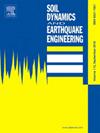通过考虑裂缝发展预测钢筋混凝土梁的抗震性能等级
IF 4.2
2区 工程技术
Q1 ENGINEERING, GEOLOGICAL
引用次数: 0
摘要
塑性旋转角或挠度通常被用作评估地震引起的破坏和划分钢筋混凝土(RC)梁抗震性能等级的指标。其中,最重要的问题之一是确定钢筋混凝土梁的抗震性能等级限值。不同国家提供了各自特定的方法,通过考虑钢筋混凝土梁的承载能力来确定限值,但这些方法无法用于描述地震引起的结构渗流,尤其是地下结构。因此,本研究采用机器学习方法,并考虑裂缝的发展情况,对 RC 梁的抗震性能等级限值进行了预测。首先,在讨论了不同规范的方法和裂缝发展情况后,介绍了 RC 梁的抗震性能等级限制。然后,在收集了 452 个钢筋混凝土梁的试验结果后,建立了钢筋混凝土梁抗震性能试验数据库,并对特征选择进行了皮尔逊相关分析,以确定机器学习的输入力学参数和尺寸参数。同时,使用互信息方法分析了输入值和极限值之间的相关性。然后建立了七种机器学习方法的回归模型来预测 RC 梁的性能等级限值,并利用 TPE 优化算法和交叉验证对机器学习模型的超参数进行了优化。评估了预测模型的泛化能力,并分析了不同方法预测结果的准确性。最后,结合钢筋混凝土梁的抗震行为,预测出的钢筋混凝土梁抗震性能等级限值可用于评估地震诱发的钢筋混凝土梁破坏。本文章由计算机程序翻译,如有差异,请以英文原文为准。
Prediction on seismic performance levels of reinforced concrete beams by considering crack development
The plastic rotation angle or deflection is typically used as the indicator to evaluate the earthquake-induced damage and classify the seismic performance levels of reinforced concrete (RC) beams. Herein, one of the most important issues is to determine the seismic performance level limits of RC beams. Whereas, different countries provided their specific method to determine the limit values by considering the loading-carrying capacity of RC beams, which could not be used to describe the earthquake-induced seepage of structures, especially for underground structures. Therefore, in this study, the seismic performance level limits of RC beams were predicted by using the machine learning methods and considering the development of cracks. Firstly, the seismic performance level limits of RC beams were presented after discussing the methods in different codes and the development of cracks. Then an earthquake performance test database of RC beams was established after collecting 452 test results of RC beams, and Pearson correlation analysis was conducted for feature selection to determine the input mechanical parameters and dimensional parameters for machine learning. Meanwhile, the correlation between the inputs and limit values was analyzed using the mutual information method. Regression models of seven machine learning methods were then established to predict the performance level limits of RC beams, and the hyperparameters of the machine learning models were optimized with the TPE optimization algorithm and cross-validation. The generalization ability of the prediction models was evaluated and the accuracy of predicted results by different methods was analyzed. Finally, the predicted seismic performance level limits of RC beams could be used to evaluate the earthquake-induced damage of RC beams by combining them with the seismic behavior of RC beams.
求助全文
通过发布文献求助,成功后即可免费获取论文全文。
去求助
来源期刊

Soil Dynamics and Earthquake Engineering
工程技术-地球科学综合
CiteScore
7.50
自引率
15.00%
发文量
446
审稿时长
8 months
期刊介绍:
The journal aims to encourage and enhance the role of mechanics and other disciplines as they relate to earthquake engineering by providing opportunities for the publication of the work of applied mathematicians, engineers and other applied scientists involved in solving problems closely related to the field of earthquake engineering and geotechnical earthquake engineering.
Emphasis is placed on new concepts and techniques, but case histories will also be published if they enhance the presentation and understanding of new technical concepts.
 求助内容:
求助内容: 应助结果提醒方式:
应助结果提醒方式:


